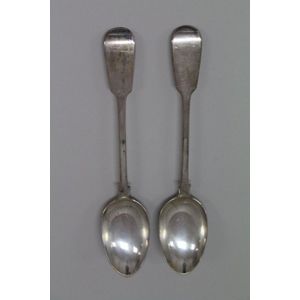English 17th Century Provincial Silver Seal Top Spoon
You must be a subscriber, and be logged in to view price and dealer details.
Subscribe Now to view actual auction price for this item
When you subscribe, you have the option of setting the currency in which to display prices to $Au, $US, $NZ or Stg.
- Acanthus - A stylized leaf motif, one of the primary decorative elements of classical Greek and Roman architecture, derived from the genus of flowering plants in the family Acanthaceae, native to tropical and subtropical regions of the Mediterranean area. It is a common element in classical Greek and Roman design, and is often seen in Corinthian and Composite order columns and used as a decorative element in English, European and Australian furniture, particularly on the curve of a leg, and as decoration for a corbel.
- Marrow Spoon - A spoon with a long handle and a narrow scoop shaped bowl, used to scoop and eat marrow from the hollow centre of roasted bones. Some marrow scoops are double ended with a different shaped bowl at each end.
- Gilding - Gilding is a method of ornamentation whereby a thin sheet of gold metal is applied to items made of wood, leather, ceramics, glass and silver for decorative purposes.
For furniture including mirrors, the sheet of gold is usually applied over a coating of gesso. Gesso is a mixture of plaster of Paris and gypsum mixed with water and then applied to the carved wooden frames of mirrors and picture frames as a base for applying the gold leaf. After numerous coats of gesso have been applied, allowed to dry and then sanded a coat of "bole", a usually red coloured mixture of clay and glue is brushed on and allowed to dry, after which the gold leaf is applied. Over time parts of the gilding will rub off so the base colour can be seen. In water gilding, this was generally a blue colour, while in oil gilding, the under layer was often yellow. In Victorian times, gilders frequently used red as a pigment beneath the gold leaf.
Metal was often gilded by a process known as fire gilding. Gold mixed with mercury was applied and heated, causing the mercury to evaporate, the long-term effect of which was to kill or disable the craftsman or woman from mercury poisoning. The pursuit of beauty has claimed many victims, not the least of which were the artists who made those pieces so highly sought after today. - Quatrefoil - A stylised four-circle design, itself contained within a larger circle, with Gothic origins and often seen as window designs in ecclesiastical architecture. The use of the motif was popular in Gothic Revival furniture of the 19th century.
- Rat Tail - A spoon with a flattened handle, tapering from the narrow section at the bowl, and wider as the top of the handle, that when viewed from above is of a similiar shape to a rat's tail. Also known as the Hanoverian pattern, as its manufacture spanned the reigns of George I, II and III (part) of the House of Hanover dynasty. The rat tail pattern was the forerunner to the Old English pattern.
This item has been included into following indexes:
Visually similar items

A George II silver apostle spoon, the apostle finial with circular nimbus chamfered corners to the shaft, traditional fig shaped bowl. Probably London 1736 by Thomas Cooke. Weight 44gms.

Georgian sterling silver sauce ladle, fiddle pattern crest to finial marked 1825, London, Henry Holland, approx 58g, 18 cm long

Pair of antique Victorian hallmarked sterling silver fiddle pattern basting spoons by Thomas Smily London 1871, 305 grams and 30 cm long (2)

Pair of William IV sterling silver dessert spoons, fiddle pattern, hallmarked London 1834 (Mary Chawner), 18.4 cm long, 108 grams
